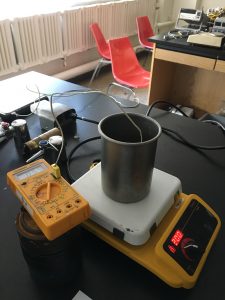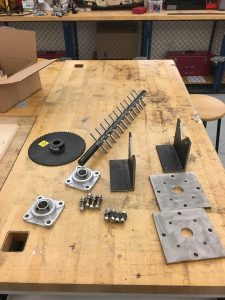 For my SIRF project, I designed a laboratory experimental setup to determine how quickly a parabolic trough solar concentrator would heat spices inside the solar receiver, a stainless steel tube. I used an electric heater to simulate the heat of the sun and 3/8” diameter wooden spheres as simulated spices with known thermal properties. A stirring mechanism inside the stainless steel tube was driven by a motor to ensure equal heating of the wooden spheres.
For my SIRF project, I designed a laboratory experimental setup to determine how quickly a parabolic trough solar concentrator would heat spices inside the solar receiver, a stainless steel tube. I used an electric heater to simulate the heat of the sun and 3/8” diameter wooden spheres as simulated spices with known thermal properties. A stirring mechanism inside the stainless steel tube was driven by a motor to ensure equal heating of the wooden spheres.
One major challenge was determining how to accurately measure the temperature of the solid wooden spheres as they were heated inside the simulated solar concentrator. Measuring the temperature of the heated solid wooden spheres in this experiment was difficult for three main reasons: the measurement space inside the tube was relatively confined; it is difficult to measure the temperature of a large nonparticulate solid because the temperature measurement probe cannot be completely immersed in the solid; and the nature of the experiment required the temperature measurement device to be relatively robust so that it would not break while the wooden spheres were stirred.
 I used a non-contact infrared thermometer to measure the temperature of the stainless steel tube while the stirring mechanism and the wooden balls were not inside the tube. The thermometer was pointed at the inside bottom surface of the tube via a slot (1” x 4”) cut in the top of the tube. This measurement method worked well for determining the temperature of the electric heater at various input voltages. Unfortunately, when the wooden spheres were placed inside the tube and the stirring mechanism was started, it was not possible to use the infrared thermometer to get an accurate temperature measurement of the wooden spheres due to the spheres’ motion.
I used a non-contact infrared thermometer to measure the temperature of the stainless steel tube while the stirring mechanism and the wooden balls were not inside the tube. The thermometer was pointed at the inside bottom surface of the tube via a slot (1” x 4”) cut in the top of the tube. This measurement method worked well for determining the temperature of the electric heater at various input voltages. Unfortunately, when the wooden spheres were placed inside the tube and the stirring mechanism was started, it was not possible to use the infrared thermometer to get an accurate temperature measurement of the wooden spheres due to the spheres’ motion.
The next temperature measurement method I tried was a SensorTag, a small device (2.5” x 2” x 0.5”) with built-in infrared and ambient temperature sensors. The SensorTag fit inside the tube, but when the motor attached to the stirring mechanism was started, the random motion of the wooden spheres inside the tube tended to move the SensorTag into a position where it would be crushed by the stirring mechanism if the motor was not switched off immediately.
I settled on using a thermocouple fed in amidst the wooden spheres through a hole in the bottom of the tube. After the first thin-wire thermocouple I chose broke while attempting to situate it inside the tube, I opted for a thermocouple with thicker wire. During testing, the thick-wire thermocouple was strong enough to hold its position among the random motion of the wooden balls inside the tube. While this method of measurement may not exactly represent the temperature of the wooden spheres, it gives a reliable indication of the ambient temperature among the spheres and thus was the temperature measurement method of choice for this experiment. I will carry this temperature measurement knowledge with me as I continue to design the solar concentrator during the Fall 2017 semester.
